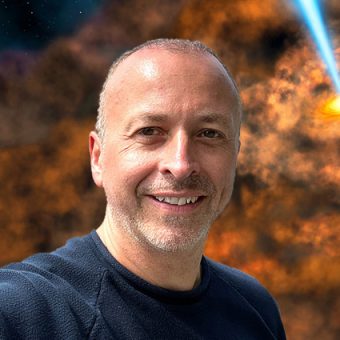
Chris Packham
Originally from Billericay, UK, Chris Packham received his undergraduate and PhD from the University of Hertfordshire. Packham is one of a select group of astronomers awarded time on the James Webb Space Telescope to observe several black holes in distant quasar-like sources in order to better understand what goes on in the center of a black holes.
Following his studies, he accepted a Japanese Society for the Promotion of Science (JSPS) fellowship at the National Astronomical Observatory of Japan where he collaborated with Japanese astronomers and taught at the University of Tokyo.
After his fellowship, Packham worked as a support astronomer at the Isaac Newton Group of Telescopes where he led the development of the near-IR adaptive optimized instrument INGRID for the 4.2 William Herschel Telescope. He then moved to the University of Florida collaborating on Thermal-Region Camera Spectrograph (T-ReCS) for the 8.1m Gemini South and CanariCam for the 10.4m Gran Telescopio Canarias as well as partnering to build a 1-5μm adaptive optimized polarimetry instrument called MMT-POL, an adaptive optics optimized imaging polarimeter for use at the 6.5m Multiple Mirror Telescope (MMT).
Packham came to UTSA in 2012 and spends most of his time researching active galactic nuclei (AGN), which are some of the most enigmatic objects in the universe. He works with MICHI, the Mid-IR Camera, High-disperser & IFU spectrograph and also participates in the San Antonio Teacher Training Astronomy Academy, an organization that aims to provide opportunities to enhance content expertise towards more confident teaching of astronomy, while also providing pedagogical and technological tools and resources to make those classes fun and interesting.
Chris Packham featured in UTSA Today article – Galaxies abound: James Webb Space Telescope creates bold new opportunities for UTSA astronomers
| Date/Time | Session | Session Type |
|---|---|---|
|
July 29, 2022
12:00 pm–1:00 pm
|
The Impending Astronomical RevolutionPresentation & Q&AThe December 25, 2021, James Webb Space Telescope (JWST) launch heralded a paradigm shift in astronomical knowledge. The telescope took 25 years of accumulated knowledge to build, with a $10 billion price tag. In this presentation I explain how JWST will help astronomers unfold the universe’s secrets like no other astronomical facility. The presentation highlights […]
|
Keynote |